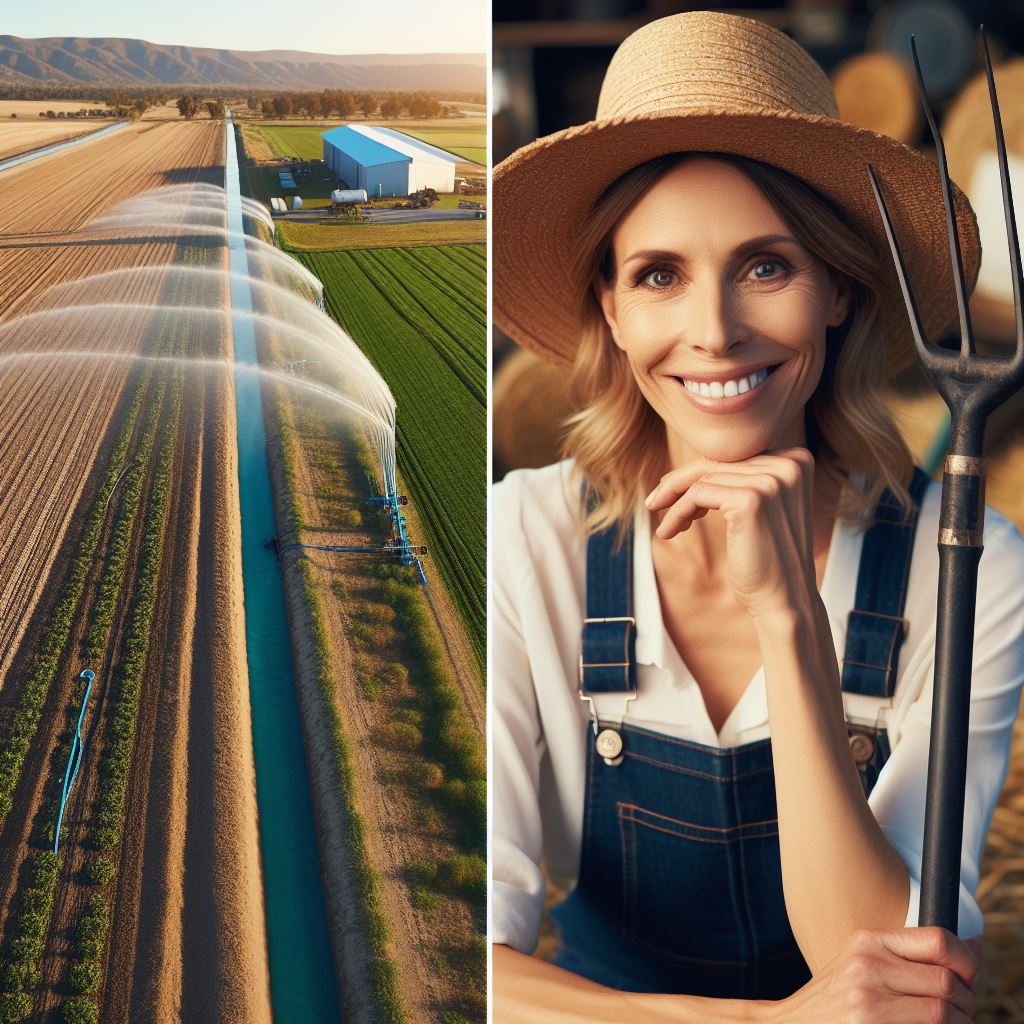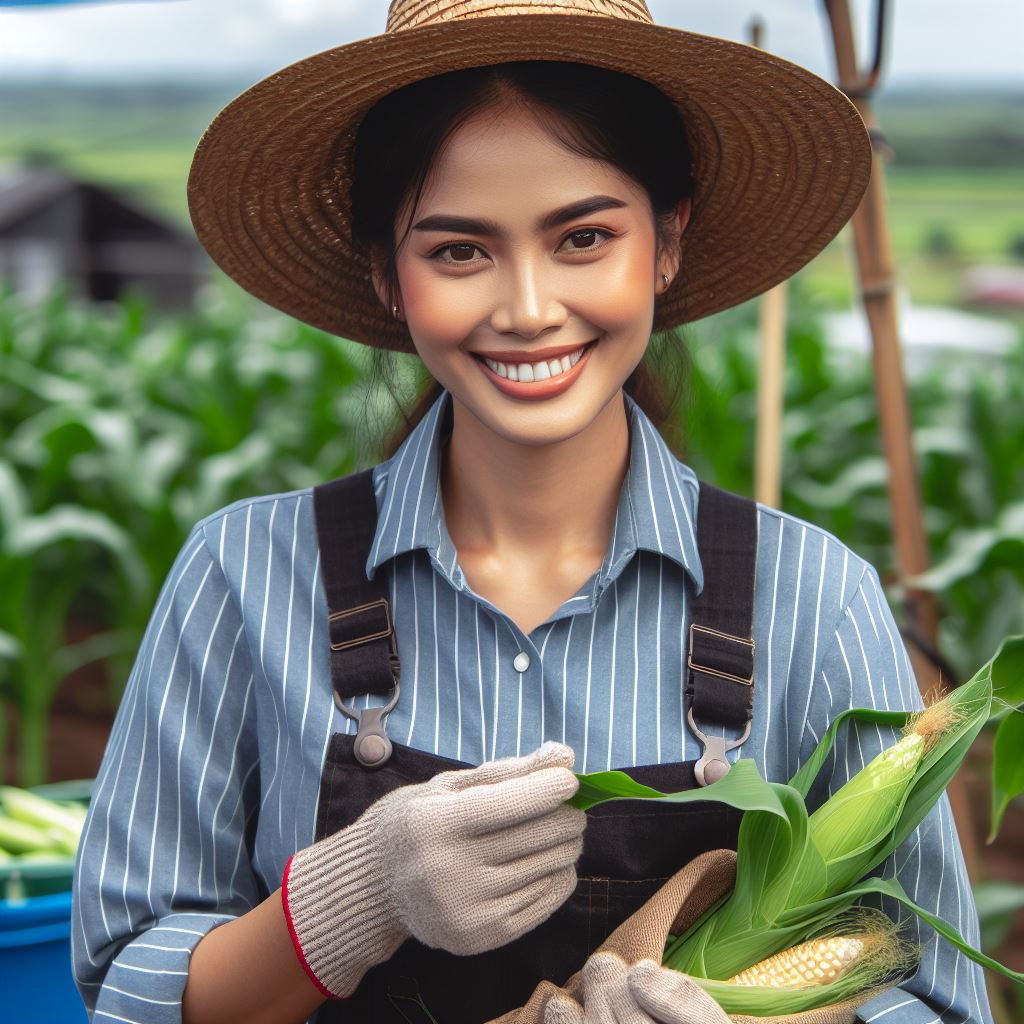Introduction
In today’s blog post, we will explore the importance of water conservation in agriculture and provide a brief overview of the current water use in this sector.
Importance of water conservation in agriculture
Water conservation plays a crucial role in agriculture as it ensures sustainable crop production and contributes to global food security.
By conserving water, farmers can minimize the depletion of water resources and protect ecosystems from potential damage.
Moreover, efficient water use in agriculture results in reduced costs for farmers and promotes economic stability in rural communities.
Overview of the current water use in agriculture
Currently, agriculture accounts for the largest share of global water consumption, using around 70% of the available freshwater resources.
Traditional irrigation techniques, such as flood irrigation, are widely used, but they are highly inefficient and result in water wastage.
To address this issue, modern irrigation methods, such as drip irrigation and precision watering, have been introduced to optimize water use.
In addition, implementing smart farming technologies and precision agriculture can further enhance the efficient use of water in agriculture.
Reducing water use in agriculture is essential for sustainable farming practices, environmental preservation, and ensuring food security for future generations.
Understanding water efficiency in agriculture
Achieving water efficiency in agriculture is essential for sustaining crop production while minimizing water use.
In this section, we will explore the definition and importance of water efficiency, as well as the factors that affect it.
Definition and importance of water efficiency
Water efficiency in agriculture refers to the ability to maximize crop yield per unit of water consumed.
It involves optimizing the use of water resources to achieve sustainable agricultural production.
Water efficiency is crucial for several reasons. Firstly, it helps conserve water, which is a finite resource.
With increasing global water scarcity, efficient water management becomes paramount to ensure food security.
Transform Your Agribusiness
Unlock your farm's potential with expert advice tailored to your needs. Get actionable steps that drive real results.
Get StartedFurthermore, water efficiency can contribute to environmental sustainability.
By reducing water use, farmers can minimize the impact on natural water bodies, prevent water pollution, and maintain ecological balance.
Moreover, improving water efficiency can enhance the economic viability of agricultural practices.
With efficient water use, farmers can reduce their operating costs, improve profitability, and remain competitive in the market.
Factors Affecting Water Efficiency
Crop selection and planting techniques
The choice of crops and planting techniques significantly influences water efficiency in agriculture.
Some crops are naturally more drought-tolerant and require less water compared to others.
Furthermore, using appropriate planting techniques such as contour plowing, terracing, and mulching can prevent water runoff, promote infiltration, and reduce evaporation losses.
Irrigation methods
The selection of the proper irrigation method is vital for water efficiency.
Different techniques, such as drip irrigation, sprinklers, and precision irrigation, can significantly reduce water wastage.
Drip irrigation, for instance, delivers water directly to the plant roots, minimizing evaporation and ensuring targeted watering.
Sprinkler systems also provide uniform coverage, reducing water loss due to uneven distribution.
Soil management
Optimal soil management practices can greatly enhance water efficiency in agriculture.
Improving soil structure through practices like organic matter addition and reduced tillage can increase water-holding capacity.
Additionally, adopting proper soil moisture monitoring and management techniques allows farmers to irrigate based on actual plant needs, avoiding over- or under-watering.
In essence, understanding and implementing water efficiency strategies in agriculture is essential for sustainable crop production.
By optimizing crop selection, irrigation methods, and soil management, farmers can conserve water, protect the environment, and achieve economic viability.
Read: Climate Stress & Soil: What Can We Do?
Efficient irrigation techniques
Drip irrigation
Definition and benefits
Drip irrigation is a method of watering crops that involves applying water directly to the plant roots.
It is highly efficient as it minimizes water loss due to evaporation and runoff.
Application methods
There are different ways to apply drip irrigation, such as surface, subsurface, and localized methods.
Surface drip irrigation uses tubes placed above the ground, while subsurface methods involve burying the tubes below the soil surface.
Challenges and considerations
Some challenges with drip irrigation include clogging of emitters, high initial installation costs, and maintenance requirements.
However, these challenges can be overcome with proper system design and regular maintenance.
Sprinkler irrigation
Definition and benefits
Sprinkler irrigation is a technique that involves spraying water over the crops.
Showcase Your Farming Business
Publish your professional farming services profile on our blog for a one-time fee of $200 and reach a dedicated audience of farmers and agribusiness owners.
Publish Your ProfileIt provides uniform coverage and can be used for different types of crops and soil types.
Different types of sprinkler systems
There are various types of sprinkler systems, including center pivot, traveling gun, and solid set.
These systems differ in their design, application, and coverage area.
Pros and cons of sprinkler irrigation
Some advantages of sprinkler irrigation include flexibility, easy installation, and suitability for irregularly shaped fields.
However, it can be less water-efficient compared to drip irrigation and may cause soil compaction.
Precision irrigation
Definition and advantages
Precision irrigation is an approach that aims to apply the right amount of water to crops at the right time.
It optimizes water use efficiency and improves crop yield and quality.
Use of sensors and technology
Precision irrigation relies on sensors and technology to monitor soil moisture, weather conditions, and plant needs.
This data helps determine the precise amount and timing of water application.
Challenges and future potential
Implementing precision irrigation systems can be costly and requires expertise in data interpretation.
However, advancements in sensor technology and data analysis hold great potential for improving water use in agriculture.
By adopting efficient irrigation techniques such as drip, sprinkler, and precision irrigation, farmers can significantly reduce water use in agriculture.
Drip irrigation, with its direct application to plant roots, minimizes water loss through evaporation and runoff. It can be applied on the surface or subsurface, depending on the farming needs.
Despite challenges like clogging, proper system design and maintenance can overcome these issues.
Sprinkler irrigation, on the other hand, involves spraying water over the crops.
It provides uniform coverage and can be used for various crops and soil types.
Different types of sprinkler systems, including center pivot and traveling gun, offer flexibility and easy installation.
However, it may be less water-efficient compared to drip irrigation and can cause soil compaction.
Precision irrigation takes a data-driven approach to optimize water use efficiency.
By utilizing sensors and technology, it monitors soil moisture, weather conditions, and plant needs.
This data helps farmers determine the precise amount and timing of water application.
Despite being costly to implement and requiring expertise in data interpretation, precision irrigation holds great potential for improving water use in agriculture.
Efficient irrigation techniques play a crucial role in sustainable agriculture.
By reducing water wastage and optimizing water use, farmers can contribute to water conservation efforts.
These techniques not only benefit farmers by improving crop yield and quality but also help to mitigate the impact of water scarcity and climate change on agricultural production.
It is essential for farmers to explore and adopt these efficient irrigation techniques to ensure a sustainable and resilient future for agriculture.
Read: Innovative Farming in a Changing Climate
Sustainable soil management practices
Importance of healthy soil in water conservation
Healthy soil plays a crucial role in conserving water in agriculture.
It has the ability to retain water and reduce runoff.
Conservation tillage and low-till farming
Definition and benefits
Conservation tillage involves reducing soil disturbance to improve overall soil health and water retention.
It helps in reducing erosion and maintaining soil structure.
Techniques and practices
Conservation tillage can include methods like strip tillage, no-till farming, and reduced tillage, which minimize soil disturbance during planting and cultivation.
Advantages for water retention
By reducing soil disturbance, conservation tillage helps to maintain soil structure and increase the infiltration of water into the soil, reducing water loss through runoff.
Cover cropping
Definition and benefits
Cover cropping involves planting specific crops during the off-season to cover the bare soil.
It helps prevent erosion, improves soil fertility, and enhances water retention.
Types of cover crops
There are various cover crop options, including legumes like clover and vetch, grasses like rye and oats, and brassicas like radishes and mustard.
Positive impact on water infiltration and retention
Cover crops create a protective layer on the soil surface, reducing water runoff and allowing water to infiltrate into the soil more effectively, thus conserving water.
In general, incorporating sustainable soil management practices like conservation tillage and cover cropping into agriculture is essential for reducing water use.
These practices not only help in water conservation but also contribute to overall soil health and ecosystem sustainability.
Crop selection and planting techniques
In order to reduce water use in agriculture, there are various strategies and techniques that can be employed.
Showcase Your Farming Business
Publish your professional farming services profile on our blog for a one-time fee of $200 and reach a dedicated audience of farmers and agribusiness owners.
Publish Your ProfileOne effective approach is crop selection and planting techniques.
Choosing drought-tolerant crops
One way to conserve water in agriculture is by selecting crops that are more resilient to drought conditions.
Advantages and factors to consider
Opting for drought-tolerant crops offers several advantages such as:
- Reduced water requirements
- Lower risk of crop failure
- Enhanced resilience to changing climate conditions
When selecting these crops, factors such as soil type, local climate, market demand, and crop characteristics must be considered.
Examples of drought-tolerant crops
There are numerous crops that have developed tolerance to drought conditions:
- Sorghum: Known for its resilience to dry conditions and efficient water usage.
- Millet: Well-suited for arid environments due to its short growing cycle and drought tolerance.
- Quinoa: Exhibits high resistance to drought and can grow in various soil conditions.
- Chickpeas: Demonstrates adaptability to areas with limited water availability.
Crop rotation and intercropping
Another way to minimize water consumption in agriculture is through crop rotation and intercropping.
Definition and benefits
Crop rotation refers to the practice of growing different crops in the same area over a sequence of seasons.
The benefits of crop rotation include:
- Improved soil health and fertility
- Reduced pest and disease pressure
- Enhanced weed control
Intercropping involves growing two or more different crops together in the same field simultaneously.
Enhancing water utilization and reducing evapotranspiration
Crop rotation and intercropping can optimize water utilization in agriculture by:
- Controlling soil erosion
- Minimizing water runoff
- Increasing nutrient cycling
- Reducing evapotranspiration through shading and windbreak effects
By employing crop selection techniques and implementing crop rotation and intercropping, farmers can effectively reduce water usage in agriculture while maintaining productivity and sustainability.
Reducing water use in agriculture is critical for sustainable farming practices.
By carefully selecting drought-tolerant crops and utilizing crop rotation and intercropping methods, farmers can conserve water resources while ensuring food production.
Read: Soil Erosion and Climate: Key Facts

Innovative technologies for water reduction
Sensor-based irrigation systems
Explanation and advantages
Sensor-based irrigation systems utilize advanced technology to accurately measure soil moisture levels, temperature, and other environmental factors, ensuring precise water application.
These systems are designed to optimize irrigation processes, resulting in significant water savings.
By utilizing sensors to constantly monitor soil moisture, farmers can avoid overwatering and ensure that crops receive just the right amount of water they need, when they need it.
This not only conserves water but also minimizes the risk of water wastage and crop damage.
Examples and success stories
Several different sensor-based irrigation systems have been developed, each with its own unique features and benefits.
One prominent example is the use of tensiometers, which measure soil water tension and provide real-time data on soil moisture levels.
Farmers can access this data remotely, enabling them to make informed decisions about irrigation schedules and water usage.
Studies have shown that implementing sensor-based irrigation systems can result in water savings of up to 40%, while increasing crop yields and quality.
Use of drones in precision agriculture
Overview of drone technology
Drones, also known as unmanned aerial vehicles (UAVs), play a crucial role in precision agriculture.
Equipped with advanced imaging and mapping capabilities, drones can gather data on crop health, water stress, and irrigation needs.
These high-resolution images provide farmers with detailed information about their fields, enabling them to make informed decisions regarding water management.
Drones are highly maneuverable and can cover large areas quickly, making them an efficient tool for monitoring crops and identifying areas that require irrigation.
Applications for water management
Drones have proven to be invaluable in water management practices.
By analyzing images captured by drones, farmers can identify areas with inadequate irrigation, water leaks, or inefficient water distribution.
This allows them to target specific areas for irrigation, reducing water waste and ensuring that crops receive sufficient water.
Drones can also assist in the assessment of irrigation infrastructure, detecting faulty pipes or sprinklers that may lead to water loss.
By addressing these issues promptly, farmers can conserve water resources and improve overall irrigation efficiency.
Limitations and future prospect
While drone technology offers significant advantages in water management, there are limitations that need to be addressed.
Drones are dependent on weather conditions, and strong winds or rain can impact their ability to operate effectively.
Additionally, drone technology is still relatively expensive, limiting its accessibility to some farmers.
However, with ongoing advancements and decreasing costs, drones are likely to become more widely adopted in the agricultural sector.
Future prospects include the development of autonomous drones that can operate without human intervention, further improving efficiency and reducing costs.
In summary, innovative technologies such as sensor-based irrigation systems and drones are revolutionizing water reduction efforts in agriculture.
These technologies provide farmers with real-time data and insights to optimize water usage, reducing waste and improving overall irrigation efficiency.
As these technologies continue to evolve and become more affordable, the agricultural sector has the potential to achieve significant water savings while ensuring sustainable crop production.
Read: Sustainable Practices for Soil Health
Showcase Your Farming Business
Publish your professional farming services profile on our blog for a one-time fee of $200 and reach a dedicated audience of farmers and agribusiness owners.
Publish Your ProfileGovernment Policies and Incentives
Overview of Regulatory and Financial Support for Water Conservation:
Government policies play a crucial role in promoting water conservation practices in agriculture.
Regulatory frameworks ensure that farmers adopt sustainable water management strategies.
Financial incentives encourage farmers to invest in modern irrigation technologies and systems.
Various grants, subsidies, and tax benefits are provided to promote efficient water use in agriculture.
These support mechanisms help farmers save water, reduce costs, and increase their overall sustainability.
Examples of Successful Governmental Initiatives
The Australian government implemented the Water Efficiency Program, which promotes water-efficient irrigation systems.
This initiative resulted in significant water savings and improved agricultural productivity.
In the United States, the USDA’s Environmental Quality Incentives Program provides financial assistance to farmers adopting water conservation practices.
This program has been successful in promoting sustainable water use and preserving natural resources.
Similar successful initiatives have been implemented in countries like Israel, Spain, and China, resulting in significant water savings and increased agricultural productivity.
Importance of Collaboration between Farmers, Industries, and Policymakers
Effective collaboration among farmers, industries, and policymakers is vital in reducing water use in agriculture.
Farmers need to be aware of the available government support and incentives.
Industries can provide technical expertise and financial resources to implement water-saving technologies.
Policymakers play a crucial role in creating favorable regulatory frameworks and providing financial support.
Collaboration ensures that water conservation strategies are effectively implemented and supported by all stakeholders.
By working together, farmers, industries, and policymakers can achieve sustainable water use in agriculture:
- Farmers can benefit from reduced water costs, increased crop yields, and long-term profitability.
- Industries can contribute to environmental sustainability and enhance their reputation as responsible corporate citizens.
- Policymakers can ensure the efficient use of water resources and promote overall agricultural sustainability.
Overall, government policies and incentives play a crucial role in reducing water use in agriculture.
By providing regulatory frameworks and financial support, governments can promote sustainable water management practices.
Successful initiatives from various countries serve as examples of the positive impact of government involvement.
Collaboration between farmers, industries, and policymakers is essential to ensure effective implementation of water conservation strategies.
With everyone working together, sustainable water use in agriculture can be achieved, benefiting farmers, industries, and the environment.
Conclusion
Recap of key points discussed
In closing, we have highlighted key points on reducing water use in agriculture.
Importance of collective efforts in reducing water use in agriculture
Collective efforts are vital for reducing water use in agriculture.
Collaboration among farmers, policymakers, and communities promotes efficient irrigation methods and water conservation practices, safeguarding precious resources for future generations.
It is crucial to emphasize the importance of collective efforts in this endeavor.
Encouragement for farmers to adopt water-efficient practices
We encourage farmers to adopt water-efficient practices to ensure sustainable agricultural production.




